I spent a hot, muddy summer working at a coal prep plant near Beckley, West Virginia. Coal slurry was my daily life. I wore it, smelled it, and sometimes, yeah, I tasted it by mistake. You know what? It’s not just black goo. It’s a whole system. For another boots-on-the-ground perspective, check out this coal slurry plant floor review.
So… what is coal slurry, really?
It’s a thick mix of fine coal and water. Think brownie batter that stains everything. It looks slick, then grabs your boots like quicksand. When the pumps run, it moves smooth. When they stop, it settles fast, like wet sand in a jar. If you want to see how the wetter, more flowable mixes behave, this hands-on take on aqueous coal slurry breaks it down in plain terms.
On shift, I took sample jars each hour. I scooped, wiped the rim, weighed the jar, and checked how thick it was. Simple job, but it mattered. If the mix got too thick, the pipe would choke. Too thin, and the coal slipped past the separators, and we lost money. That hour-by-hour jar grab might seem routine, but the insights from the NIOSH Occupational Hazard Assessment on coal liquefaction plants note that sampling and maintenance are prime windows for exposure to toxic materials, so attention to PPE and ventilation saved my skin more than once.
A day with the slurry
We used a big Warman slurry pump with rubber liners. Loud as a freight train, but steady. I’d watch the gauge, listen for that low growl, and feel the pipe hum. On good days, the flow stayed smooth and the spray bar kept the belt clean. A lot of the day-to-day feels just like what’s described in this account of running a coal slurry pipeline.
One morning, the line sat for maybe three minutes while a valve stuck. Boom—settled solids. We flushed with water, banged the elbow (with a mallet, not our hands—learned that fast), and got it going again. Reading about the crew who rode the Black Mesa coal slurry pipeline gave me plenty of déjà vu.
Another time, a summer storm hit. Power blinked. Pumps stopped. The slurry settled like a rock. We had to cut the line pressure, crack a cleanout, and wash it down for an hour. My boots filled with gray soup. I still smell that day. The cleanup drill echoed scenes from this first-hand review of a coal slurry spill.
What I liked
- It moves fine coal well. Pipe beats hauling loose dust by truck.
- Less dust in the air. My lungs thanked me.
- When it runs steady, it feeds burners nice and even. We ran a small test boiler once, and the flame stayed calm.
- Rubber-lined pumps and hoses last longer than I thought, if you treat them right.
What bugged me
- It’s messy. It stains skin, clothes, and even my lunch pail. It finds a way.
- If flow stops, it settles fast. Three minutes can cost three hours.
- It chews through metal parts. Elbows wear thin; we kept spares on a shelf.
- Winter is rough. Lines need heat wrap, or they gel up. Summer is better, but splashes get everywhere.
- The smell sticks to you. Kind of oily, kind of clay. Not awful—just… always there.
When it finally comes time to get rid of the waste mix, this coal slurry disposal guide has saved me more than once.
Little lessons I learned (sometimes the hard way)
- Keep it moving. Flow is king. Even a slow trickle beats a dead stop.
- Flush lines before breaks and shift change. Future you will be grateful.
- Label sample jars. Wet coal looks like wet coal, and mix-ups are costly.
- Double-glove. Inner glove for warmth, outer glove for grime.
- Carry extra gaskets. When you need one, you need it now.
- Have spill pads ready. They’re not just for show.
- Don’t set your snack on the handrail. Coal dust on a granola bar tastes like pennies. Ask me how I know.
Safety talk, straight and simple
We wore face shields, rubber boots, and hearing protection. Slurry pumps are loud, and splash happens. Slip hazards are real. We washed down decks with a fire hose and used grit to keep footing. One coworker skipped eye gear once. He didn’t do that again. Stories like the Martin County coal slurry spill survivor’s experience drive the point home. To see how the pros spell it out, the Health and Safety Authority's slurry safety guidelines detail the drowning and gas-poisoning dangers that hide in every pit and the simple steps—like ventilating stores and staying out during agitation—that back up everything our foreman drilled into us.
For a deeper dive into sludge-handling do's and don'ts, SludgeSafety.org gives straight-shooting tips that could save your skin and your shift.
A quick aside: winter vs. summer
In winter, the slurry gets thicker. We kept the water warm and checked heat tape on lines. In July, it thins out. Flows easier, but splatter gets wild. I preferred hot days. Easier to clean, even if my socks got soggy. If you’re holding slurry in ponds, this first-hand take on coal slurry impoundments is required reading.
Who this makes sense for
- Prep plants that need to move fine coal without clouds of dust
- Power sites set up to burn slurry or reprocess fines
- Labs and pilot lines testing blends
Not a backyard project. This is big gear, long hoses, and trained crews. And if your town shares water with a line, the Arizona coal slurry pipeline water project story shows the community side.
My take, heart on sleeve
Coal slurry is tough but honest. I’m not alone—check out this honest take on coal mine slurry for a viewpoint that lines up with mine. When you treat it right, it pays you back with smooth flow and fewer dust problems. When you ignore it, it throws a fit. It’s not glamorous. It’s loud, wet, and kind of stubborn. But I felt proud when the line ran steady, the gauges sat where they should, and the deck stayed clean.
Would I work with it again? Yeah, with a good crew and decent gear. I’d bring extra socks, a better face shield, and a big thermos of coffee. On those rare nights off when we still had energy to burn, a few of us looked for ways to unwind that didn’t involve more coal talk—if you’re in the same boat, the no-pressure hookup site Instabang lines up casual, local meet-ups fast so you can relax, recharge, and be back on shift before the dawn whistle. If you lean toward a classifieds-style approach that feels like the personal ads of old, swing by Doublelist Green to browse or post discreet, interest-based listings—its quick filters and free access make it easy to set up a low-stress meetup that fits neatly between shifts.
Rating: 3.5 out of 5
- Works well for what it’s made to do.
- Demands care, time, and a strong wash station.
- Worth it when the system is set up right.
You know what? Coal slurry isn’t just black sludge. It’s a rhythm. Once you catch it, the whole plant breathes easier.

